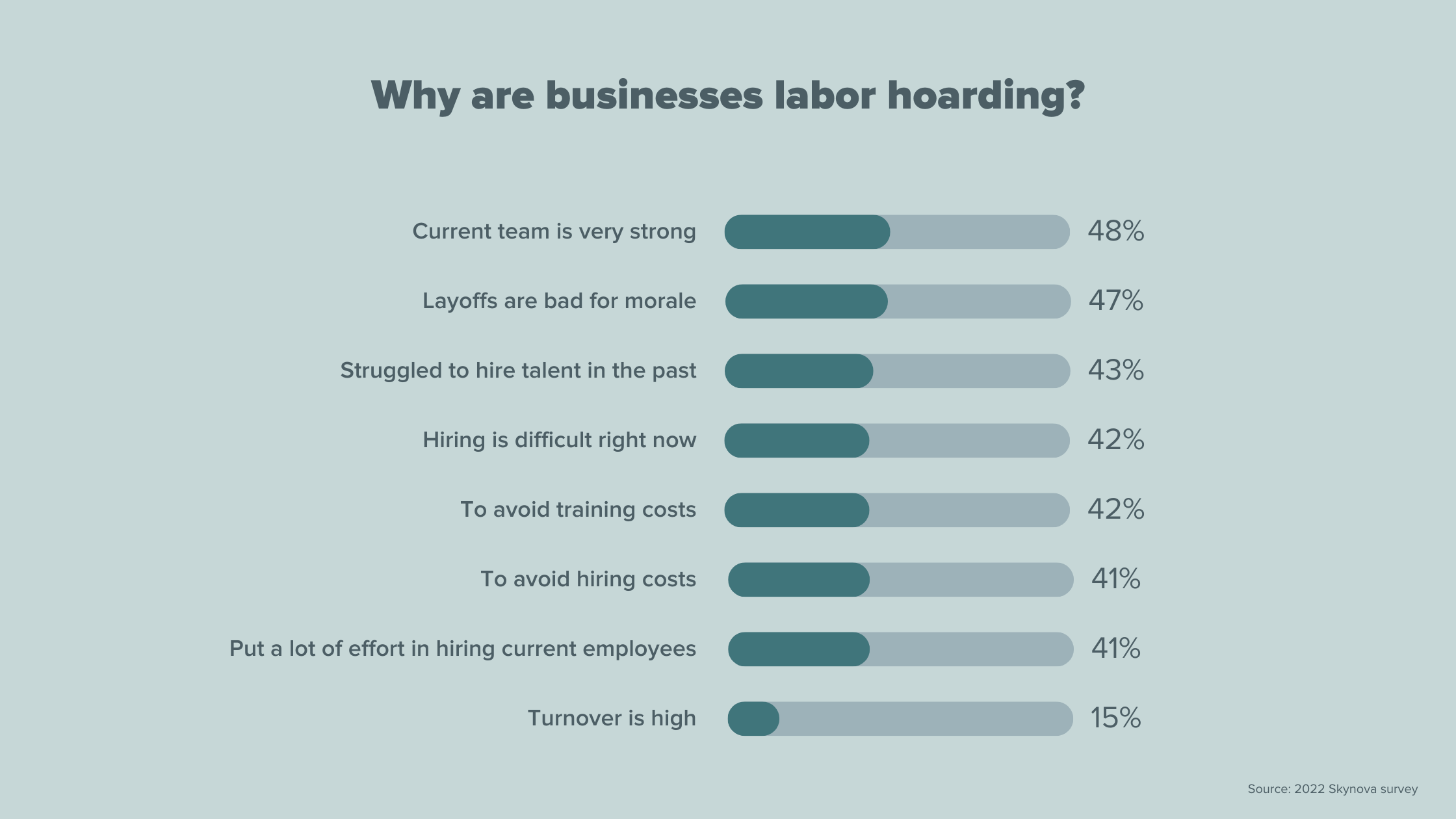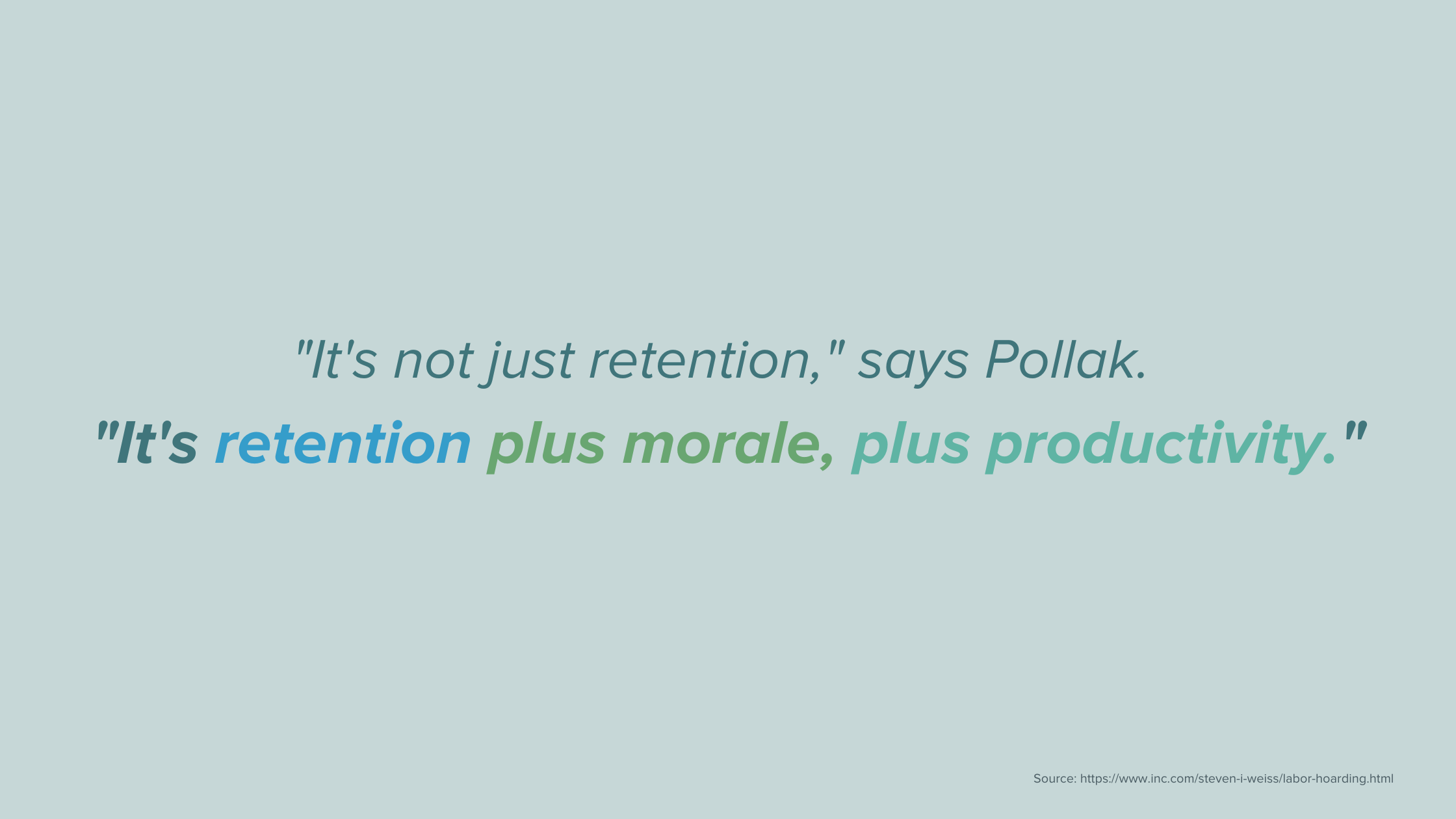Remember at the beginning of the pandemic when we all started hoarding toilet paper, yet none of us knew why, exactly?
A new kind of hoarding is trending as the recession takes hold of the American workforce, but this one seems to make more sense. Meet labor hoarding, a strategy that is taking hold of over 75% of the American workforce.

Labor hoarding occurs when an employer aims to retain its current workers by ramping up their investing practices in existing employees, increasing benefits, and clinging to existing employees for dear life -- partly because replacement costs are so high (and these folks are already good at their jobs) and partly as a competitive move due to their fear of potential talent shortages. It's a shift in the common tendency of reducing staff in times of declining economic conditions, focusing on the long-term strategy of your business instead of the short-term fix of reducing costs by letting people go.
This term originated in the manufacturing industry, where companies would keep extra workers on hand to be prepared for unexpected demand. However, it's now being used in a broader sense to describe any company that holds onto its employees.
So, let's dive into what labor hoarding is and what it looks like, shall we?
Labor hoarding by the numbers
According to a Skynova survey, 91% of small business owners are labor hoarding, and 89% plan to continue doing so in 2023. Some of the reasons given include that their current talent is very strong (48%), layoffs affect the morale of their team (47%), and their past struggles to hire (43%).

Seven in 10 small businesses also cited inflation and a potential recession as reasons to avoid firing employees. If forced to let employees go, 74% said they would rehire them after the economy recovered.
It's also interesting to note that 42% mentioned they wanted to avoid training costs, and 41% wanted to avoid hiring costs as well. This seems to be working, as Skynova reports that small business owners said they're saving $4,541 per hire on average by holding onto their current workers.
On the employee side, it seems like the idea of staying put is an appealing one in a tight labor market.
An Insight Global survey in November 2022 marked that 77% of Americans plan to stay at their job in 2023. This is a marked shift from The Great Resignation we saw in 2021 when 53% of employed adults quit their job for a career change.
73% of workers have also said that the fear of a possible recession has led them to focus on upskilling, buffing up their hard and soft skills, and even taking on new projects at work to make sure they keep their jobs.
What does labor hoarding look like?
So, what are some of the strategies that businesses are deploying to keep their current workforce?
I'm so glad you asked.
More than half of businesses (60%) have conducted a hiring freeze, the Skynova survey states, with other tactics such as turning to remote work to avoid leasing costs (53%) and implementing a four-day workweek for a few workers (48%).
Overall, it seems like the role of managers in holding onto their current employees has also been essential. 67% of small business owners said that they would be willing to cut their own salary to avoid firing their employees. Employees in management roles are even more inclined to take a pay cut, with (75%) managers saying they would be willing to do so.
Other efforts made by small businesses to prevent their teams from quitting include:
-
Improving compensation (50%)
-
Using transparent communication (46%)
-
Investing in a suitable work environment (44%)
-
Providing remote work opportunities (44%)
-
Offering more paid time off (PTO) (16%)
Overall, it seems like building a good company culture and having an effective retention strategy are crucial to maintaining your current employees. Business leaders want to focus on the balance between compensation-related benefits and a strong company culture, making sure their company is the ideal place for their people.
The cost of hiring and recruiting top talent
Have you tried to hire for a role, thinking it'd be easy, but then found yourself screaming at the HR gods a big, dramatic "WHYYYYYY?!" after months of searching?
Us, too.
.gif?width=690&height=388&name=giphy%20(1).gif)
"Labor market dynamics have fundamentally changed: time-to-hire, recruiting costs, and hiring costs have all grown substantially,"
- Julia Pollak, chief economist at ZipRecruiter
Companies have to work unusually hard to hire new team members, and the cost of hiring, training, and getting to a point where a new employee is functional in their role adds up quickly. It's also not just the monetary costs that can affect a company: team morale and company culture can be severely affected by high turnover rates.
At a time when skilled workers are focused on the right fit for their jobs, it is essential to keep your team motivated so they can focus on being productive.

ZayZoon's take on labor hoarding
I spoke with our president, Tate Hackert, about labor hoarding at ZayZoon and he emphasized the importance of keeping employees at a time when filling job openings can be a pain, as well as the unexpected hiring and training costs that come with recruiting new talent.
"Recruiters typically take around 20% of the first year salary for placing a candidate. This ain’t cheap. $60,000 salaried employee would cost the business an additional $12,000!" Tate said.
Other costs that aren’t as obvious include résumé sorting and reviewing (at ZayZoon, we receive anywhere from 20 to 300 applications for an open position), interviewing and negotiating, and the time it takes to find talent that is the right fit for the company.
"At ZayZoon, we shortlist and interview around five candidates for each role, three of these will be longer form (90-minute) interviews, typically with two or three ZayZoon leaders. Depending on the position, there may be further interviews/conversations to ensure the candidate and ZayZoon are both comfortable moving forward. This adds up quickly. A new senior hire could take more than 50 combined hours in conversation before we move forward"
"I think the moral of the story is: it’s expensive to lose a team member. Very expensive. So leaders need to be proactive in how they look at hiring, compensating, and benefiting their team." Tate said.
Size matters: labor hoarding for small businesses
With the looming economic recession, labor shortages, and a need to cut costs, there are several things that small business owners can do to avoid layoffs.
Big companies such as Amazon and the U.S. military have advanced business analyst roles focused specifically on tactics like the compensation, accessions, and personel management (CAPM) model and the dynamic retention model to calculate the value in a large number of employees that fill similar roles, and the costs of hiring and training new employees to replace them, should they leave.
Although this can be beneficial for big companies, many businesses just don't have the resources that Amazon does to implement these models, and in many cases, with only one person in a specific role, they don't provide as many benefits as it would for a bigger company.
So, how do small businesses avoid layoffs and keep their talent?
You're just killing it with these questions.
The least popular method was to let go of freelance and contract workers (28%). But large businesses were far less likely to let their gig workers go. In fact, they were the ones most likely to cut their own salaries to avoid laying anyone off (82%) compared to small businesses (67%) and medium-sized companies (41%).
Other tips for maintaining talent include:
-
Having an effective retention strategy
-
Investing in your existing employees' soft skills
-
Providing professional development opportunities
-
Improving open communication
-
Sharing the overarching strategy of the company and where you are going
-
Investing in compensation-related benefits like Earned Wage Access, employee discounts, and more.
Labor hoarding as part of a bigger strategy
It almost sounds too good to be true, doesn't it? You get to keep your employees, they get to keep their jobs, and you don't have to pay recruiters, or invest more resources into onboarding new team members. As with all strategies, labor hoarding has to be done as part of a larger, long-term plan, and not just as an easy fix.
It's essential to be transparent about what the long-term strategy of the business is and to make sure that every employee is engaged, aligned with their role, and has a clear understanding of where the business is going. It's also essential that workers do not feel like they're redundant, or being kept on as backup.
Talent hoarding isn't for everyone. It doesn't address a company’s need to add new skilled hires into their workforce, or those who are in a growth phase and still need new employees to keep up.
Companies can look at diversifying the kind of talent that they bring on, hiring services from agencies, or engaging gig workers to fill certain positions in a more temporary way. Whatever is right for your business, it is important to note what others have done and then strategically design your own gameplan moving forward.
The right move for your business?
You know that one quote you'll see on LinkedIn a thousand times where a CFO asks the CEO: “What happens if we invest in developing our people and then they leave us?” and the CEO (in their best Yoda voice) replies: “ What happens if we don’t, and they stay?”
Labor hoarding is basically that.
There's no denying the competitive advantage businesses wield in the war for talent when they hoard workers. If you have all the talent, what is your competitor left with? And isn't it just better to keep investing in the amazing team you have than to keep hunting for new talent?
Labor hoarding is not a new term (it's recorded at a U.S Senate hearing in 1945, even) and many employers that are practicing this trend would probably not even call it that, but it does seem to be an interesting move for companies in times of uncertainty.
It seems to be mutually beneficial for employees and employers as long as there is a long-term strategy that includes this practice and the roles of employees are communicated transparently in a way that they know how they're going to grow with the organization.
Get started today
It'd be almost rude if I didn't mention this: if you want to add a free financial wellness benefit that will help your employees save money and improve their financial skills, get in touch with us today and offer ZayZoon, the financial empowerment benefit for SMBs.
.jpg?width=290&name=SusyA-Photo%20(1).jpg)





.jpg?width=300&name=hannah-busing-Zyx1bK9mqmA-unsplash%20(1).jpg)
.jpg)



